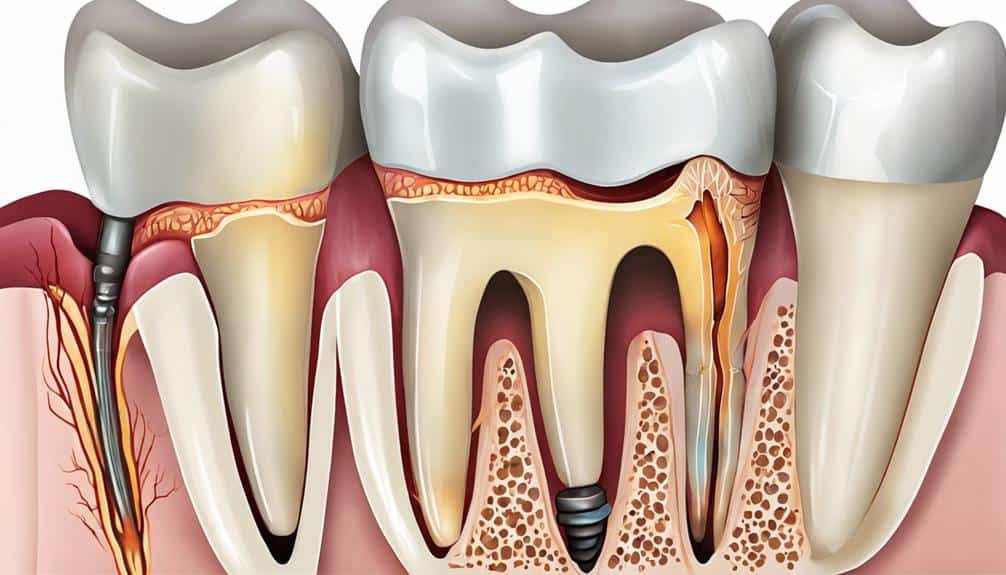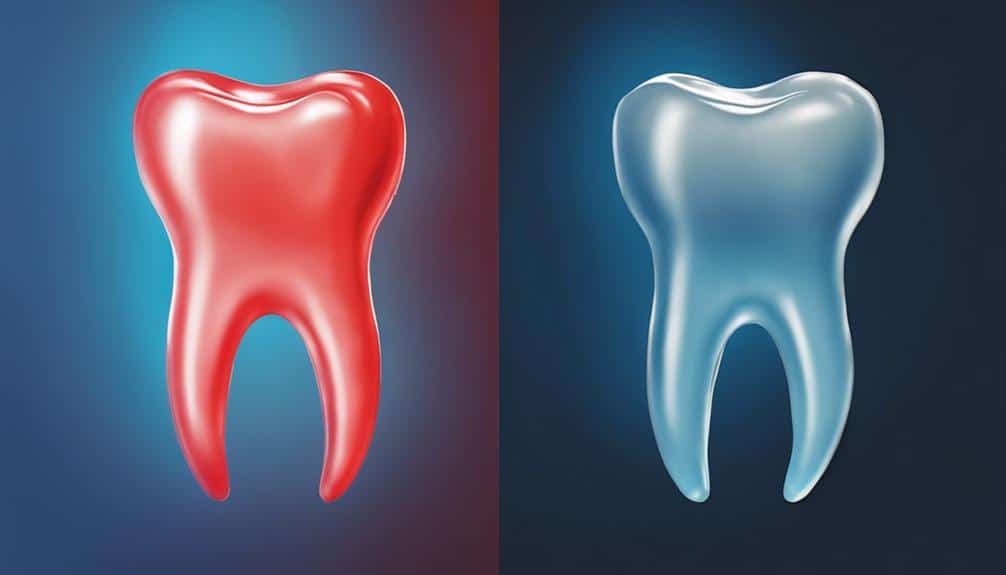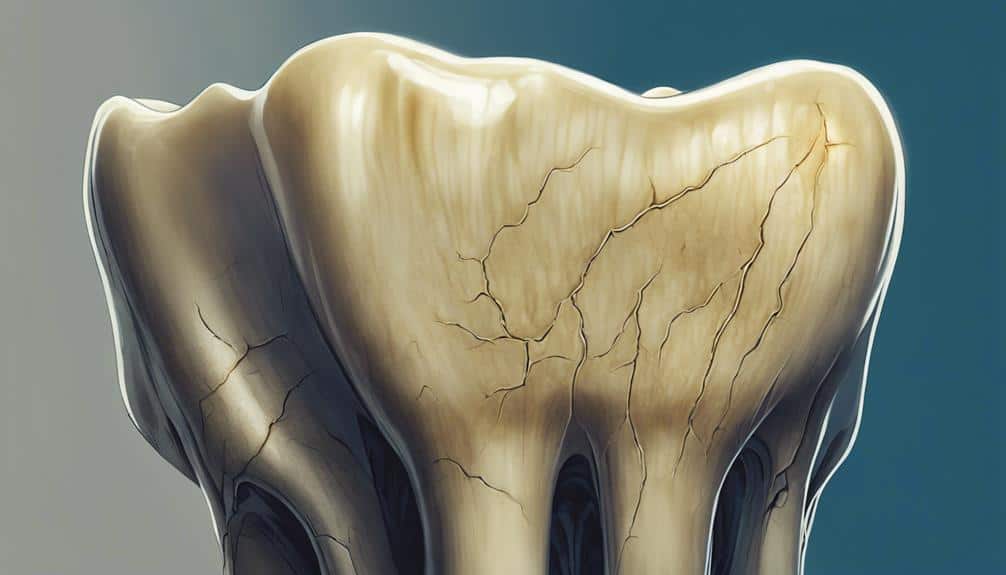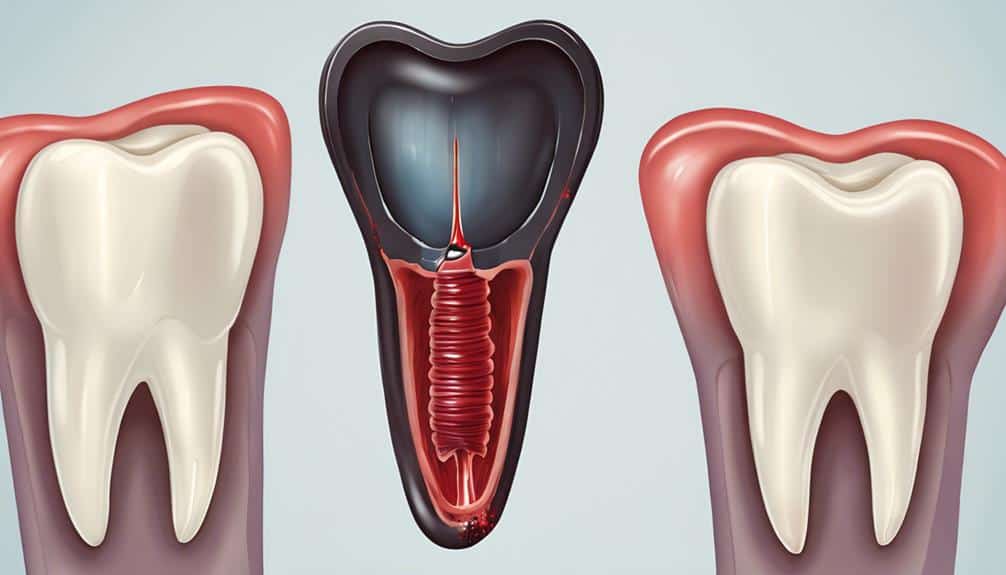If you've got a cavity, you're probably wondering how long it'll take to turn into a root canal. The answer is, it depends on you. Your oral hygiene habits, diet, and the location and severity of the decay all play a role. If you neglect your teeth, a cavity can progress to a root canal in mere months or even weeks. But with good habits and regular dental visits, you can slow it down. Want to know the secrets to stopping tooth decay in its tracks?
Key Takeaways
• The rate of cavity progression to a root canal varies depending on oral hygiene, diet, and tooth health.
• Good oral hygiene and regular dental visits can slow down cavity progression, while poor hygiene and sugary diets accelerate it.
• Early warning signs like tooth sensitivity, pain, and discoloration can indicate rapid cavity progression, requiring prompt attention.
• Weaker enamel and deep cavities can accelerate the need for a root canal, while healthy enamel and good hygiene slow it down.
• Catching cavities early and addressing them promptly is crucial in preventing the need for a root canal.
Factors Affecting Cavity Progression
Your cavity's progression is influenced by a combination of factors, including the health of your enamel, your oral hygiene habits, and the diet choices you make.
The strength of your enamel, for instance, plays a significant role in determining how quickly a cavity spreads. Weaker enamel can lead to faster decay, while healthy enamel can slow down the progression.
Your oral hygiene habits are also vital, as regular brushing and flossing can prevent bacteria from accumulating and contributing to cavity growth.
Additionally, the food and drinks you consume can either help or harm your teeth. A diet high in sugary and acidic substances can accelerate cavity progression, while a balanced diet can help slow it down.
By understanding the interplay between these factors, you can take proactive steps to prevent cavities from forming and progressing.
Cavity to Root Canal Timeline

As you learn about the cavity to root canal timeline, it's crucial to recognize the early warning signs that can indicate a cavity is progressing rapidly.
You'll want to understand the factors that influence the cavity progression rate, which can vary greatly from person to person.
Early Warning Signs
Recognize the earliest indicators of a cavity's progression to a root canal, including tooth sensitivity, pain, discoloration, and gum swelling, which signal decay's reach into nerve tissue.
As you monitor your oral health, be aware of these early warning signs that indicate a cavity is advancing. Tooth sensitivity, for instance, can be a sign that decay is nearing the pulp, requiring prompt attention to prevent further damage.
Similarly, pain, discoloration, and gum swelling are all indicators that a cavity is progressing rapidly. Your oral hygiene habits, diet, and individual tooth health all play a role in the speed of decay spread.
By staying vigilant and addressing cavities promptly, you can prevent the need for a root canal and maintain excellent oral health. Remember, timely treatment is essential in preventing the progression of a cavity to a root canal.
Stay ahead of the game by recognizing these early warning signs and taking proactive steps to protect your teeth and gums.
Cavity Progression Rate
The rate at which a cavity progresses to necessitate a root canal can vary greatly, influenced by factors such as your oral hygiene habits, diet, and the location of the affected tooth. In general, it can take anywhere from a few months to up to five years for a cavity to progress to the point of needing a root canal.
Poor oral hygiene and a diet high in sugar can expedite the cavity progression rate, allowing decay to advance more quickly. If you have enamel decay or deep cavities, you may experience a faster progression to needing a root canal.
On the other hand, maintaining good oral hygiene habits and visiting your dentist regularly can slow down the cavity progression rate. By catching cavities early, you can prevent them from advancing to the point of requiring a root canal.
Regular dental check-ups and early cavity treatment are key in preventing decay from advancing to a root canal. By taking control of your oral health, you can decrease the likelihood of needing a root canal.
Tooth Decay Causes and Risks

When you consume sugary foods and drinks on a regular basis, you greatly elevate your risk of tooth decay, which can lead to cavities and potentially even a root canal if left untreated. This is because bacteria in your mouth feed on the sugars, producing acid that erodes your teeth and leads to decay.
Here are some key factors that increase your risk of tooth decay and cavity formation:
- Sugary diet: Consuming sugary foods and drinks regularly increases your risk of tooth decay.
- Smoking: Smoking cigarettes heightens the risk of tooth decay and cavity formation.
- Poor oral hygiene: Failing to brush and floss regularly allows bacteria to thrive, leading to tooth decay.
If left untreated, tooth decay can progress, leading to cavities. Untreated cavities can further progress, reaching the nerve tissue and potentially requiring a root canal procedure.
It's essential to maintain good oral hygiene habits and visit your dentist regularly to prevent tooth decay and cavity formation.
Signs You Need a Root Canal

If you're experiencing intense pain or discomfort in a specific tooth, especially when chewing or applying pressure, it may be a sign that you need a root canal. This severe toothache could be an indication that decay has reached the pulp of your tooth, necessitating a dental intervention.
Additionally, if you're sensitive to hot or cold temperatures in a specific tooth, it may be a sign that the decay has progressed to the nerve, requiring a root canal.
Other signs that you may need a root canal include swollen or tender gums around a tooth, which could signal that decay has reached the nerve. Discoloration of a tooth, especially darkening, can also be a sign that decay has progressed to the nerve, requiring a root canal.
Furthermore, pus drainage or a persistent bad taste in the mouth near a tooth may indicate the need for a root canal due to infection. If you're experiencing any of these symptoms, it's essential to consult a dental professional to determine the best course of treatment.
Stopping Tooth Decay in Its Tracks

You can prevent tooth decay from spiraling out of control by catching cavities early and addressing them promptly. By doing so, you can halt the cavity progression and avoid the need for a root canal.
Maintaining good oral hygiene habits, reducing sugary food intake, and promptly addressing cavities are essential in stopping tooth decay in its tracks.
Here are three essential steps to prevent tooth decay:
- Practice good oral hygiene: Brush your teeth at least twice a day and floss daily to remove plaque and bacteria that can cause cavities.
- Attend regular dental check-ups: Regular dental check-ups can help identify cavities early, allowing for prompt treatment and preventing further decay.
- Address cavities promptly: If you do develop a cavity, don't delay treatment. The sooner you address the issue, the less likely it's to progress to the point where a root canal is necessary.
Preventing Cavities and Root Canals

As you take steps to prevent cavities from turning into root canals, you'll want to focus on developing good oral hygiene habits, such as regular brushing and flossing, as well as scheduling regular dental check-ups.
By doing so, you'll be able to catch any potential issues early on and prevent them from escalating into more serious problems.
Brushing and Flossing Habits
Developing consistent brushing and flossing habits is essential to preventing cavities from progressing to root canals. By adopting good oral hygiene practices, you can greatly reduce the risk of cavities turning into root canals. Here are three key habits to focus on:
- Brushing: Brush your teeth at least twice a day for two minutes each, using fluoride toothpaste to strengthen your enamel and prevent decay.
- Flossing: Floss daily to remove plaque and food particles that can lead to decay and cavities.
- Timing: Make brushing and flossing a priority by doing them at the same time every day, so it becomes a habit.
Regular Dental Check-Ups
Regular dental check-ups every six months are essential in detecting cavities at an early stage, allowing for timely interventions that can prevent them from progressing to the point of needing a root canal.
By incorporating regular dental check-ups into your oral health routine, you can identify cavities early on and take preventive measures to stop them from escalating.
During these check-ups, dental cleanings remove plaque and tartar, reducing the risk of cavities developing and potentially leading to root canals. Your dentist can also recommend preventive measures such as fluoride treatments or dental sealants to strengthen your teeth and prevent cavities that could lead to root canals.
Healthy Diet Choices
You can take control of your oral health by making informed dietary choices, as a well-balanced diet plays a crucial role in preventing cavities and reducing the risk of needing a root canal. By making healthy diet choices, you can greatly lower the chances of cavities progressing to the need for a root canal.
Here are three essential dietary habits to adopt:
- Limit sugary foods and drinks: Consuming high amounts of sugary foods and drinks can increase the risk of developing cavities and potentially needing a root canal.
- Opt for nutrient-rich foods: Fruits and vegetables are rich in nutrients that can help strengthen teeth and prevent cavities.
- Choose calcium-rich foods: Dairy products and leafy greens are rich in calcium, which supports healthy teeth and contributes to cavity prevention.
What Happens During a Root Canal

During a root canal procedure, your dentist will typically administer a local anesthetic to numb the affected tooth and surrounding area before accessing the pulp chamber to remove the infected or damaged tissue. This is necessary when decay has advanced beyond the tooth's enamel and dentin layers, reaching the inner nerve tissue and causing inflammation or infection in the pulp.
In this procedure, the dentist will carefully remove the infected or damaged tissue, clean the area thoroughly, and then seal it to prevent further issues. This prevents the infection from spreading and causing more severe problems, such as abscess formation or severe pain.
By removing the infected tissue, the root canal procedure helps to eliminate the source of the infection and prevent further damage to the tooth.
Through this procedure, your dentist aims to save your tooth and prevent the need for extraction. By addressing the decay and infection promptly, you can avoid more complex and costly treatments down the line.
Delaying the Need for a Root Canal

As you learn more about cavities turning into root canals, it's important to understand that early detection plays a vital role in preventing the need for this procedure.
By ignoring symptoms or delaying treatment, you're taking a substantial risk of allowing the decay to progress, making a root canal more probable.
Fortunately, with proper oral hygiene practices and regular dental check-ups, you can greatly delay or even avoid the need for a root canal altogether.
Early Detection Matters
Regular dental check-ups can be a crucial factor in detecting cavities at an early stage, allowing for timely treatment and potentially delaying the need for a root canal. By catching cavities early, you can prevent them from progressing to the point where a root canal is necessary.
Here are three ways early detection can benefit you:
- Preventative care: Regular check-ups enable your dentist to identify cavities before they reach advanced stages, allowing for simple fillings instead of complex procedures.
- Timely treatment: Early detection enables prompt treatment, reducing the risk of decay spreading to the inner layers of your tooth.
- Root canal prevention: By treating cavities promptly, you can prevent the decay from reaching the nerve, eliminating the need for a root canal procedure.
Ignoring Symptoms Risks
If you neglect to address symptoms like toothaches, sensitivity, and discoloration, you're taking a significant risk that can ultimately lead to the need for a root canal. By ignoring these warning signs, you're allowing decay to progress from the enamel to the nerve tissue, increasing the likelihood of needing a root canal.
The longer you delay treatment, the deeper the decay can penetrate into the tooth, potentially leading to irreversible damage.
Delaying treatment can turn a simple cavity into a complex problem. What could have been treated with a simple filling can escalate into a more invasive and costly procedure.
Regular dental check-ups and prompt treatment of cavities can help avoid the need for a root canal procedure. Don't wait until it's too late – if you're experiencing a toothache, sensitivity, or discoloration, don't ignore it. Seek professional help to prevent decay from advancing and potentially requiring a root canal.
Early intervention can make all the difference in saving your tooth and avoiding unnecessary pain and expense.
Early Warning Signs of Tooth Decay

You can identify early warning signs of tooth decay by watching for white spots on your teeth, sensitivity to hot or cold foods, bad breath, and visible holes or pits in your teeth. These signs indicate that cavity progression is underway, and if left unchecked, can lead to a root canal.
Here are three important things to keep in mind:
- Regular dental check-ups are essential:
Regular dental check-ups can help detect early signs of tooth decay, allowing for timely intervention and prevention of root canals.
- Neglecting early signs has consequences:
Neglecting early signs of tooth decay can lead to cavity progression, reaching the nerve tissue and potentially requiring a root canal.
- Proper oral hygiene is vital:
Proper oral hygiene, including brushing, flossing, and regular dental cleanings, can help prevent tooth decay from advancing to the need for a root canal.
Protecting Your Teeth From Decay

By adopting a consistent oral care routine, you can greatly reduce your risk of developing cavities that could eventually lead to root canals. Regular brushing and flossing help remove plaque and bacteria that can erode your enamel and create cavities. Additionally, limiting sugary and acidic foods and drinks can slow down cavity progression. By doing so, you can prevent the need for dental fillings and more extensive procedures like root canals.
Moreover, maintaining good oral hygiene habits and seeking timely dental care can help catch cavities early, making treatment simpler and less invasive. This is important, as unchecked cavities can rapidly progress, requiring more complex and costly treatments.
Frequently Asked Questions
How Fast Can a Cavity Turn Into a Root Canal?
You're wondering how fast a cavity can turn into a root canal? The truth is, it's a highly individualized process. Factors like your oral hygiene habits, diet, and even genetics influence the pace of decay. If you have good oral hygiene and a healthy diet, you may be able to slow down the progression of a cavity. However, if you have poor oral hygiene habits and a diet high in sugar and acid, a cavity can progress more quickly. In some cases, a cavity can progress to the point of needing a root canal in as little as a few months. It’s important to visit your dentist regularly to monitor the progression of cavities and to determine the appropriate dentist appointment duration for your specific needs.
While some cavities can rapidly progress within months, others may take years to reach the nerve.
The good news is that with timely treatment, you can prevent the need for a root canal procedure altogether.
How Bad Can a Cavity Get Before You Need a Root Canal?
While you wait to address that pesky cavity, it's crucial to know how bad things can get before a root canal becomes necessary. The truth is, a cavity can progress rapidly if left untreated, potentially causing severe pain, abscesses, and even tooth loss.
If decay reaches the pulp, you're likely looking at a root canal. Don't wait until it's too late; prioritize regular dental check-ups to catch cavities early and prevent them from spiraling out of control.
How Do I Know if My Cavity Turned Into a Root Canal?
'Congratulations, you've made it to the party!
But, seriously, if you're wondering if your cavity turned into a root canal, pay attention to your body's whispers. Are you experiencing severe tooth pain, sensitivity, or discoloration? Those are red flags. Don't ignore them!
Schedule a dental check-up ASAP. A dentist can assess the damage and determine if you need a root canal.
Don't wait; timely treatment can save your tooth and your sanity.'
How Fast Do Root Canals Form?
You're wondering how fast root canals form. The truth is, it's not the root canal that forms, but rather the progression of tooth decay that leads to the need for one.
Decay can spread rapidly, requiring a root canal within months, or it may take up to five years. Your oral hygiene, diet, and cavity location all play a role in determining the timeline.



